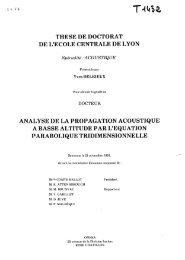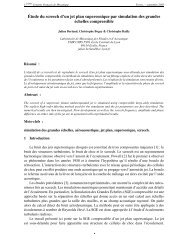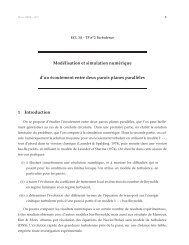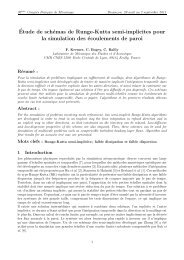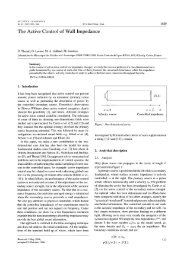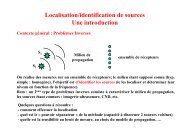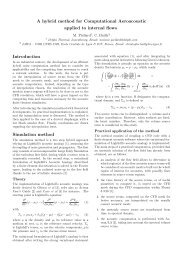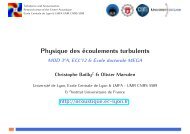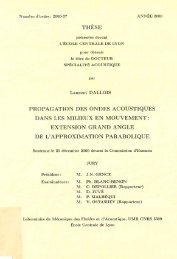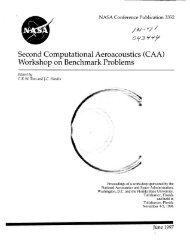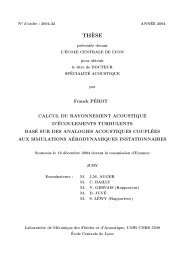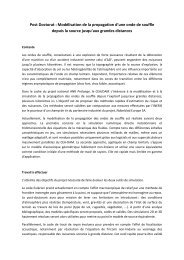On the radiated noise computed by large-eddy simulation
On the radiated noise computed by large-eddy simulation
On the radiated noise computed by large-eddy simulation
You also want an ePaper? Increase the reach of your titles
YUMPU automatically turns print PDFs into web optimized ePapers that Google loves.
Phys. Fluids, Vol. 13, No. 2, February 2001 <strong>On</strong> <strong>the</strong> <strong>radiated</strong> <strong>noise</strong> <strong>computed</strong> <strong>by</strong> <strong>large</strong>-<strong>eddy</strong> <strong>simulation</strong><br />
B. Implementation of a priori and a posteriori tests<br />
for LES<br />
To compute <strong>the</strong> contributions of <strong>the</strong> tensors appearing in<br />
<strong>the</strong> decomposition of <strong>the</strong> Lighthill tensor, a priori tests have<br />
been carried out <strong>by</strong> filtering <strong>the</strong> flow field <strong>computed</strong> with a<br />
direct numerical <strong>simulation</strong>. A Gaussian filter function has<br />
been used for <strong>the</strong> present <strong>simulation</strong>, whose associated kernel<br />
in physical space G and transfer function G ˆ are, respectively,<br />
Gy 6<br />
2<br />
1/2<br />
exp 6y<br />
2 2<br />
Gˆ k<br />
exp 2 k 2<br />
24 . 15<br />
This Gaussian filter induces a smooth separation between<br />
resolved and subgrid quantities, resulting in a nonzero contribution<br />
of low frequencies to <strong>the</strong> latters. The effects of <strong>the</strong><br />
filter have been investigated for three values of <strong>the</strong> normalized<br />
wave number k c (k c7,15,31) leading to a representation<br />
of <strong>the</strong> field on 16 3 ,32 3 and 64 3 grids, respectively. A<br />
<strong>large</strong>-<strong>eddy</strong> <strong>simulation</strong> using a parametrization of <strong>the</strong> subgrid<br />
scale tensor occurring in <strong>the</strong> Navier–Stokes equation is performed<br />
to complete <strong>the</strong> study with a posteriori tests. Aerodynamic<br />
fluctuations generated <strong>by</strong> stationary turbulence may<br />
be <strong>computed</strong> <strong>by</strong> resolving incompressible Navier–Stokes<br />
equations which are written as<br />
<br />
t ūi <br />
ū<br />
y<br />
iū j<br />
j<br />
<br />
y i<br />
<br />
p¯<br />
y i<br />
<br />
y j<br />
<br />
ū<br />
y<br />
j<br />
i<br />
<br />
ū<br />
y i <br />
j<br />
<br />
<br />
y<br />
ij, 16<br />
j<br />
ū i0, 17<br />
where ij is <strong>the</strong> subgrid scale tensor. Then <strong>the</strong> <strong>radiated</strong> <strong>noise</strong><br />
is deduced using <strong>the</strong> filtered Lighthill equation 6 where <strong>the</strong><br />
associated Lighthill tensor is given <strong>by</strong> T ¯ ij 0(ū iū j ij).<br />
The subgrid scale tensor parametrization is required in<br />
momentum and Lighthill’s equation but this parametrization<br />
is not required to be <strong>the</strong> same for both equations. It is worth<br />
noting that <strong>the</strong> subgrid terms appearing in <strong>the</strong>se two equations<br />
correspond to very different physical mechanism classical<br />
inter-scale interactions in <strong>the</strong> momentum equation and<br />
<strong>noise</strong> production for <strong>the</strong> Lighthill source term which are<br />
associated to different ma<strong>the</strong>matical formulations: simple divergence<br />
of <strong>the</strong> subgrid tensor in <strong>the</strong> momentum equations,<br />
and a second-order derivative of <strong>the</strong> same tensor in <strong>the</strong><br />
Lighthill equation. It appears <strong>the</strong>n that different models can<br />
be derived for <strong>the</strong>se two terms. A ‘‘perfect’’ model for <strong>the</strong><br />
subgrid fluctuations or <strong>the</strong> subgrid tensor ij could <strong>the</strong>oretically<br />
be used to parametrize both effects, but previous works<br />
<strong>by</strong> Seror et al. 17 have shown that such a model remains to be<br />
derived. Two different models will be used in <strong>the</strong> present<br />
study. The spectral models used in momentum equations developed<br />
<strong>by</strong> Métais and Lesieur 32 leads to <strong>the</strong> subgrid scale<br />
tensor<br />
FIG. 1. Geometry of sound source radiation. VVolume of turbulent fluid,<br />
Mobserver position, D2.<br />
ijt <br />
ū<br />
y<br />
j<br />
i<br />
<br />
ū<br />
y i , 18<br />
j<br />
where t(k) (k) is <strong>the</strong> turbulent viscosity. The effective<br />
viscosity is written as follows:<br />
k1 K 0 3/2<br />
15.2 exp3.03kc /k. 19<br />
Métais and Lesieur 32 developed a spectral dynamic model to<br />
compute <strong>the</strong> <strong>eddy</strong> viscosity based on an adaptation of <strong>the</strong><br />
spectral-cusp model to kinetic-energy spectra proportional to<br />
km . The <strong>eddy</strong> viscosity is <strong>the</strong>n such as<br />
0.31 5m<br />
m1 K 0 3/2 Ek c<br />
k c<br />
if m3. 20<br />
For m3 <strong>the</strong> <strong>eddy</strong> viscosity is set equal to zero.<br />
C. Implementation of Lighthill’s analogy<br />
The acoustic field is evaluated from Lighthill’s analogy.<br />
The source term is assumed to be nonzero only in a finite<br />
region V. Then for any observer defined <strong>by</strong> <strong>the</strong> vector x, and<br />
located outside this volume V as shown in Fig. 1, application<br />
of <strong>the</strong> Green’s function formalism yields<br />
x,t 1 1 <br />
2 4c 0<br />
Vxy<br />
2<br />
T<br />
y<br />
ij y,t<br />
iy j<br />
xy<br />
c d<br />
0 3y, 21<br />
where is <strong>the</strong> averaged density outside <strong>the</strong> flow domain V.<br />
This ensemble average is performed over 24 different<br />
observers located at <strong>the</strong> same distance from <strong>the</strong> center of <strong>the</strong><br />
computational domain. As detailed <strong>by</strong> Witkowska 10 and Bastin<br />
et al. 7 three formulations of <strong>the</strong> solution can be expressed<br />
from Eq. 21. The formulation retained for <strong>the</strong> present work<br />
is <strong>the</strong> one successfully used <strong>by</strong> Witkowska 10 and Sarkar and<br />
Hussiani 20 in isotropic turbulence formulation and which is<br />
derived from Eq. 21 <strong>by</strong> applying <strong>the</strong> divergence <strong>the</strong>orem<br />
twice: 33<br />
x,t 1 xix j 2 d3y. 4c 0 4<br />
x 3 V<br />
t 2 Tij y,t xy<br />
c 0<br />
Downloaded 17 Mar 2003 to 156.18.39.49. Redistribution subject to AIP license or copyright, see http://ojps.aip.org/phf/phfcr.jsp<br />
479<br />
22



